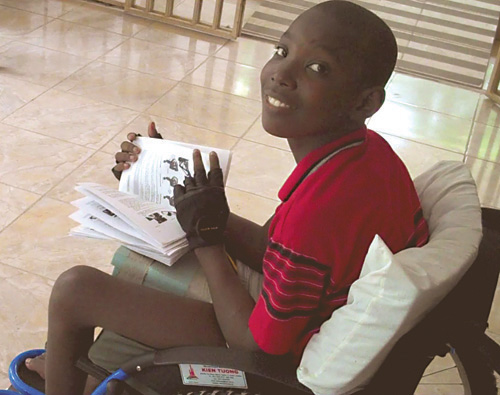
Ralf Hotchkiss, co-founder and chief engineer of SF State’s Whirlwind Wheelchair International, has visited many developing countries, but Haiti after the earthquake was still something of a shock. "It was rough. It was the most devastated infrastructure I’ve ever been in," he says from the workshop in SCI 251 where he teaches a wheelchair design class. Last May Hotchkiss and other members of Whirlwind’s staff went to Haiti to distribute 350 of their RoughRider wheelchairs to people with spinal cord injuries and amputations. Hotchkiss, who has been using a wheelchair since a motorcycle accident left him paralyzed more than four decades ago, shakes his head when remembering the conditions in the capital. "Most of Port au Prince has yet to be excavated," he says. "Volunteers were still hauling rubble one five gallon paint bucket at a time."
"It was rough. It was the most devastated infrastructure I’ve been in."
—Ralf Hotchkiss
The terrible state of Haiti’s infrastructure makes it a perfect candidate for Whirlwind’s much praised RoughRider, a wheelchair specifically designed for the irregular terrain —rocks, grass, mud, broken concrete, wooden planks, gravel— of the developing world. Unlike conventional wheelchairs, RoughRiders are agile, easily maneuverable, and made of nearly indestructible steel (to prove this, Hotchkiss slams his front wheels down on the concrete, sending a reverberating clang throughout his workshop).
But usability is only one of the concerns when thinking about the lives of wheelchair users in developing nations. According to the World Health Organization, there are 20 million people in the developing world who need a wheelchair and do not have one.
Without wheelchairs most of these people are unable to work or attend school and spend much of their lives in bed. This lack of mobility contributes to pressure sores, the most common cause of death for people with spinal cord injuries. Often, when wheelchairs are available, they are poorly suited to the area and they break.
Whirlwind’s mission is to address all of these issues. Their chairs must be tough, but they must also be affordable, easily fixed and made from parts readily available throughout the world. Get ting the design exactly right has been a 30 year odyssey and the life’s work of Hotchkiss, who, in 1989 won a MacArthur "Genius" Grant for his efforts.
On a Tuesday night in September, students meet with Hotchkiss in the Whirlwind workshop, a room strewn with wheelchair parts inside SF State’s Science building. They are working on the handgrips for the wheelchair they will build together over the course of the semester. In the flurry of sanding and welding, Hotchkiss moves about the room to advise and answer questions.
Like Hotchkiss, many of the students maneuver around the room in wheelchairs, but not because they need them. Part of the aim of the class is to help students understand the needs of wheelchair users.
The rewards of the engineering come when chairs reach the riders who need them. Earlier this year Hotchkiss and his Whirlwind colleagues arrived in Haiti for the first time with the help of the Walkabout Foundation, which raised the money to buy the wheel chairs from workshops in Mexico and Vietnam and deliver them in Haiti. "I’ve wanted to get into Haiti for a long time," says Hotchkiss. "We were looking for ways to get there and then we met the people from Walkabout and they got busy fundraising."
They arrived as patients with severe injuries from the earthquake were being released from hospitals. They were going home, usually a shack or tent, where they might stay without the aid of a durable wheelchair. Whirlwind distributed RoughRiders in three locations, providing chairs that don’t get stuck in muddy ground or tip over on the rocky terrain. The staff also trained 46 rural community health workers to fit and adjust the chairs to individuals’ needs.
Many people who sustained spinal cord injuries in the earthquake died in the first three months. "When we arrived every patient we met had massive pressure sores," says Hotchkiss. "Not a single [patient who received a RoughRider] has died since."
In rural Haiti, five hours from Port au Prince, a teenage boy named Vladimir was among the first RoughRider recipients. He sustained a spinal cord injury in the earthquake when his bedroom ceiling fell on his neck. "Vladimir had fun on the trails around his hospital, learning how to use his wheelchair to navigate rocky, grassy and muddy surfaces," says Marc Krizack, Whirlwind’s executive director. "With his new RoughRider, he will be able to get himself to school each day."
Although there were many young people like Vladimir who were injured in the earthquake, other children need wheelchairs because of conditions including cerebral palsy and spina bifida. "These are kids who would be in school if they could get there," says Whirlwind’s Keoke King, explaining that while these children are small, they are often carried to school by their siblings. "But then as they grow heavier, they end up at home, and because standing is difficult or impossible they spend most of their lives on the floor."
In an effort to change that, Whirlwind is working on a new chair, one designed specifically for children.
Read about more about Hope for Haiti